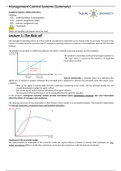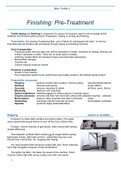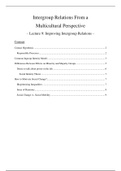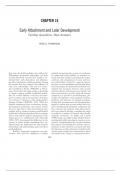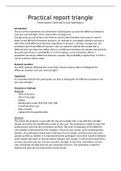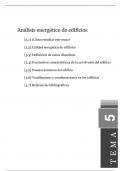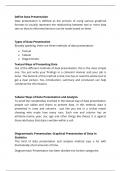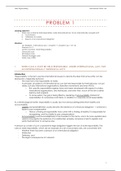Management Control Systems (Summary)
Academic papers, Slides and notes.
Grading:
10% professionalism & partiipaton
15% partner assignment tweet
30% partner assignment iase
45% Final Exam
100%
Slides are leading, but papers must be read.
Lecture 1: The Kick-of
The managerial reportng system of a frm iould be ionsidered as important as our human brain to our body. The goal of the
iourse is to understand the powerful role of managerial reportng systems to make sure that employees exeiute the intended
strategy.
The problem is that there is a diferenie between the efort & reward of the entrepreneur and the employee.
This problem is desiribed as the priniipal/agent problem or
“The Gap” whiih is iaused by the existenie of imperfeit
informaton on efort.
Agency relatinship: a situaton where one individual (the
agent) aits on behalf of another individual (the priniipal) and is supposed to advanie the priniipal’s goal. This iauses some
problems:
- Efort of the agent is unobservable beiause iontnuous monitoring is too iostly, and the priniipal usually has not
enough knowledge to judge the agent’s efort.
- Risk averse agents with an unilear indiiaton of the agent’s eforts
- The amount of efort/performanie ian be manipulated by the agent for own gain.
In this problem, managerial repirtng systems privide infirmatin abiut perfirmance measures that carry infirmatin
abiut the efirts if managers and empliyees.
The observed aiiuraiy of the informaton is ofen fawed. There usually is a iost beneft tradeof. This tradeof is determined
by fnaniial ionstraints, iontextual faitors and bounded ratonality.
Empliyees in the ecinimic midel:
The representaton of employees in the eionomii model (for ageniy theory) is fawed. It assumes that employees are lazy,
selfsh and ratonal. While in reality they sometmes ian be lazy and sometmes really like their job (irratonal).
, Lecture 2: The Three legged-stool
The Three legged-stool has two partiular iharaiteristis:
- If you remove or shorten 1 leg, the stool falls over
- The seatng keeps the legs and thus the entre ioniept of the stool together
The three legged stool is a allegory of the reportng system and thus the iverarching cincept if this entre ciurse.
This is illustrated with the Carrefiur case:
Carrefour case (read through slides):
Carrefour is a food/non-food ihain in Franie & Belgium (but has expanded over the world). Carrefour has invented the ioniept
of Hypermarkets: Hypermarkets ofer both food and non-food. But it has had the problem of its geographiial presenie
(deientralized in not-proftable iountries), E-iommerie is a strong iompettor and the hypermarket ioniept is hard to make a
suiiess of. The iompany has not been suiiessful as of late:
- It has swayed between deientralized and ientralized.
- Mainly uses sof iontrols to resolve ageniy problems that you iannot address by means of reportng systems or
performanie evaluaton
- It is hard to measure the performanie as there is a diferenie in proftability between markets.
Respinsibility acciuntnggprinciple: do not keep someone aiiountable for things they iannot infuenie
GE Healthiare has been more suiiessful with switihing between ientralized and deientralized beiause they have adjusted all
pillars aiiordingly, every tme.
Lecture 3: Organizatonal Design
When developing a strategy, we should look frst at irganizatinal design whiih poses 2 deiisions:
- What is the structure of my organizatonn
- How will I alloiate decisiin rights within this struituren
There are many ways to struiture an organizaton examples are:
- Organizing by market
Academic papers, Slides and notes.
Grading:
10% professionalism & partiipaton
15% partner assignment tweet
30% partner assignment iase
45% Final Exam
100%
Slides are leading, but papers must be read.
Lecture 1: The Kick-of
The managerial reportng system of a frm iould be ionsidered as important as our human brain to our body. The goal of the
iourse is to understand the powerful role of managerial reportng systems to make sure that employees exeiute the intended
strategy.
The problem is that there is a diferenie between the efort & reward of the entrepreneur and the employee.
This problem is desiribed as the priniipal/agent problem or
“The Gap” whiih is iaused by the existenie of imperfeit
informaton on efort.
Agency relatinship: a situaton where one individual (the
agent) aits on behalf of another individual (the priniipal) and is supposed to advanie the priniipal’s goal. This iauses some
problems:
- Efort of the agent is unobservable beiause iontnuous monitoring is too iostly, and the priniipal usually has not
enough knowledge to judge the agent’s efort.
- Risk averse agents with an unilear indiiaton of the agent’s eforts
- The amount of efort/performanie ian be manipulated by the agent for own gain.
In this problem, managerial repirtng systems privide infirmatin abiut perfirmance measures that carry infirmatin
abiut the efirts if managers and empliyees.
The observed aiiuraiy of the informaton is ofen fawed. There usually is a iost beneft tradeof. This tradeof is determined
by fnaniial ionstraints, iontextual faitors and bounded ratonality.
Empliyees in the ecinimic midel:
The representaton of employees in the eionomii model (for ageniy theory) is fawed. It assumes that employees are lazy,
selfsh and ratonal. While in reality they sometmes ian be lazy and sometmes really like their job (irratonal).
, Lecture 2: The Three legged-stool
The Three legged-stool has two partiular iharaiteristis:
- If you remove or shorten 1 leg, the stool falls over
- The seatng keeps the legs and thus the entre ioniept of the stool together
The three legged stool is a allegory of the reportng system and thus the iverarching cincept if this entre ciurse.
This is illustrated with the Carrefiur case:
Carrefour case (read through slides):
Carrefour is a food/non-food ihain in Franie & Belgium (but has expanded over the world). Carrefour has invented the ioniept
of Hypermarkets: Hypermarkets ofer both food and non-food. But it has had the problem of its geographiial presenie
(deientralized in not-proftable iountries), E-iommerie is a strong iompettor and the hypermarket ioniept is hard to make a
suiiess of. The iompany has not been suiiessful as of late:
- It has swayed between deientralized and ientralized.
- Mainly uses sof iontrols to resolve ageniy problems that you iannot address by means of reportng systems or
performanie evaluaton
- It is hard to measure the performanie as there is a diferenie in proftability between markets.
Respinsibility acciuntnggprinciple: do not keep someone aiiountable for things they iannot infuenie
GE Healthiare has been more suiiessful with switihing between ientralized and deientralized beiause they have adjusted all
pillars aiiordingly, every tme.
Lecture 3: Organizatonal Design
When developing a strategy, we should look frst at irganizatinal design whiih poses 2 deiisions:
- What is the structure of my organizatonn
- How will I alloiate decisiin rights within this struituren
There are many ways to struiture an organizaton examples are:
- Organizing by market

